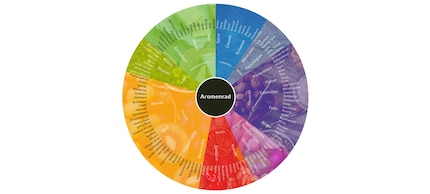
Recognising and classifying the taste of wine
Our taste buds can describe over ten thousand different aromas and millions of smells. Correctly naming what we taste is not always easy when different impressions are intertwined. An aroma wheel, or knowing the characteristic aromas of different grape varieties, can help you to recognise the fine nuances of different wines.
There are many aspects that influence the diversity of aromas present in wine. The grape variety and its clones*, the vintage, the terroir*, the growing conditions, the conditions during the harvest as well as the choice of reasons, the vinification* and the age of the wine have a strong influence on the taste of the wine.
The origin and differentiation of aromas
In the science of wine (oenology), aromas are divided into three categories. Primary aromas are mainly influenced by the grape berry and growing conditions. The grapes of most varieties, such as Chasselas and Chardonnay, are fairly neutral in taste, so these primary aromas are only present in small quantities. Other varieties such as Sauvignon Blanc and Gewurztraminer have spicier aromas.
Secondary aromas are the aromas that come from fermentation. That is, the transformation of sugar into alcohol and micro-organism activity. So the choice of yeast and ferments plays a role as does the choice of barrel and many other factors. These aromas are present in almost all wines with similar characteristics and ensure the vinous character of the beverage.
Tertiary aromas come from the period during which wines are aged in vats or barrels. Indeed, the amount of oxygen absorbed by the wine during its ageing period and the type of container in which it is stored, the wine will reveal different types of aromatic molecules. These aromas are fairly limited in most commercially available wines.
Smelling aromas using the aroma wheel
The aroma wheel is a system for describing aromas in a sensory way. These wheels exist not only for wine, but also for other foods or drinks such as coffee, chocolate, tea and whisky.

Here's also a wine aroma wheel
The wheel is made up of three circles. The one in the centre is divided into eight main odour categories. The centre circle has 25 categories detailing the eight major odour categories. The largest circle is made up of 119 aromas based on the categories in the central circle.
The wheel helps you to better describe the aromas in their complexity and discover the subtleties of each wine. You can easily start from the inside and work your way out, discovering new aromas.
The wheel helps you better describe the aromas in their complexity and discover the subtleties of each wine.
«Clone»: selection of perfectly similar vine plants, obtained from a single plant by multiplication of a single vine. «Terroir»: a group of soils whose nature, geographical configuration and climate enable the exploitation of specific products. «Vinification»: all the processes by which grape juice is transformed into wine.
Back to overview: [[marketingpage:6817]]
Friends, family, cats and good wine are my lifeblood.
Interesting facts about products, behind-the-scenes looks at manufacturers and deep-dives on interesting people.
Show all